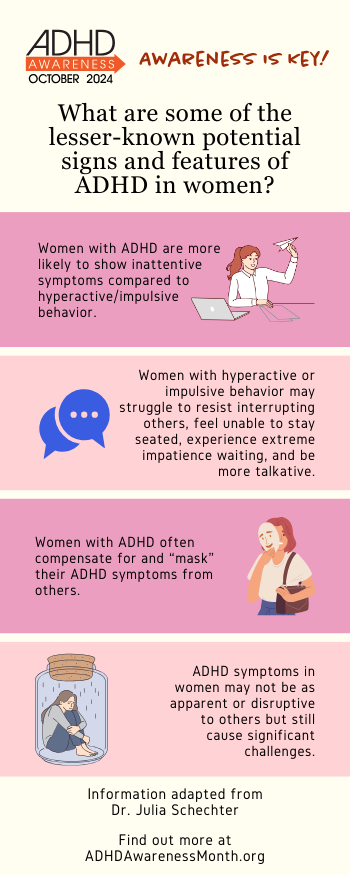Women with ADHD often experience more inattentiveness rather than hyperactive/impulsive behavior, leading to difficulties like distraction during conversations, avoiding tedious household chores, or frequently running late to activities. Though these symptoms may not be as apparent or as disruptive to others, they are no less impairing: women with ADHD are at high risk for anxiety, self-harm, and suicide attempts. Understanding the symptoms and unique experience of women with ADHD is crucial for better identifying and supporting this population.

ADHD symptoms in women can look different from the stereotypical image people often picture when they think of person with ADHD. Women with ADHD are more likely to show inattentive symptoms compared to hyperactive/impulsive behavior. Women who are inattentive may “zone out” during conversations, get into car accidents because they are easily distracted, avoid paying bills because the chore feels too tedious, or frequently run late because they have trouble organizing their time.
Although women can also have the hyperactive/impulsive symptoms, these might not manifest as the “ants in your pants” activity levels people often expect with ADHD. Instead, women may struggle to resist interrupting others during conversations, feel unable to stay seated during meals or while watching television, experience extreme impatience when waiting in lines, or be more talkative even at times they do not want to be.
Additionally, women with ADHD often compensate for and “mask” their ADHD symptoms from others. For example, they may have achieved good grades at school, but often had to “pull all-nighters” to complete their schoolwork. They may perform well at their jobs, but had to work twice as hard as colleagues to stay organized.
Moreover, compared to girls and women without ADHD, girls and women with ADHD are more likely to experience co-occurring conditions, such as anxiety disorders and oppositional behaviors. Compared to boys and men with ADHD, they are more likely to experience disordered eating, engage in self-harm, and die prematurely.
Collectively, ADHD symptoms in women not be as apparent or disruptive to others but still cause significant challenges. Understanding the unique presentation and experience of ADHD is crucial for improving identification of and support for women with ADHD.
About the Author

Dr. Julia Schechter is a licensed clinical psychologist and Assistant Professor at the Duke University School of Medicine. She serves as the co-director of the Duke Center for Girls & Women with ADHD.
Resources:
- Babinski DE, Neely KA, Ba DM, Liu G. Depression and Suicidal Behavior in Young Adult Men and Women With ADHD: Evidence From Claims Data. The Journal of Clinical Psychiatry. 2020;81(6).
- Dalsgaard, S., Østergaard, S. D., Leckman, J. F., Mortensen, P. B., & Pedersen, M. G. (2015). Mortality in children, adolescents, and adults with attention deficit hyperactivity disorder: a nationwide cohort study. Lancet (London, England), 385(9983), 2190–2196. https://doi.org/10.1016/S0140-6736(14)61684-6
- Hinshaw, S. P., Nguyen, P. T., O’Grady, S. M. & Rosenthal, E. A. (2021). Annual Research Review: Attention-deficit/hyperactivity disorder in girls and women: underrepresentation, longitudinal processes, and key directions. Journal of Child Psychology and Psychiatry. https://doi.org/10.1111/jcpp.13480
- Mikami, A. Y., Hinshaw, S. P., Arnold, L. E., Hoza, B., Hechtman, L., Newcorn, J. H., & Abikoff, H. B. (2010). Bulimia nervosa symptoms in the multimodal treatment study of children with ADHD. International Journal of Eating Disorders, 43(3), 248–259.
- Skoglund, C., Poromaa, I. S., Leksell, D., Selling, K. E., Cars, T., Giacobini, M., … Kallner, H. K. (2023). Time after time: failure to identify and support females with ADHD – a Swedish population register study. Journal of Child Psychology and Psychiatry. doi: 10.1111/jcpp.13920
- Tung I, Li JJ, Meza JI, Jezior KL, Kianmahd JSV, Hentschel PG, O’Neil PM, Lee SS. Patterns of Comorbidity Among Girls With ADHD: A Meta-analysis. Pediatrics. 2016;138(4):e20160430.
- Young S, Adamo N, Ásgeirsdóttir BB, et al. Females with ADHD: An expert consensus statement taking a lifespan approach providing guidance for the identification and treatment of attention-deficit/ hyperactivity disorder in girls and women. Bmc Psychiatry. 2020;20(1):404. doi:10.1186/s12888-020-02707-9
